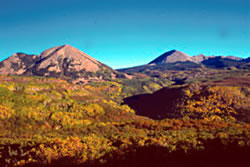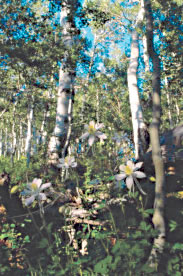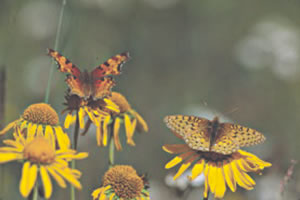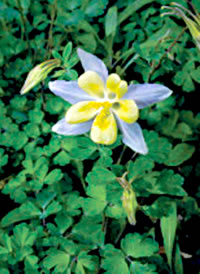As
the July mercury rises, so does my desire to venture up into
the mountains. Driven by the “3 degrees for every 1000
feet in elevation” theory, I pack my gear for an elevational-attitude-adjustment
and depart for the mountains.
 The
local peaks, the La Sals, offer a respite from this July
heat wave. Topping out at over 12,000 feet, I know there
is a whole lot of room to roam up there. Even if it is
for only a day, the difference in altitude will make
a profound change in my attitude. The
local peaks, the La Sals, offer a respite from this July
heat wave. Topping out at over 12,000 feet, I know there
is a whole lot of room to roam up there. Even if it is
for only a day, the difference in altitude will make
a profound change in my attitude.
Driving the switchbacks above Ken’s Lake, I leave the beloved desert
below to bake in its own insanity. Above me forest greenery shines like
a beacon of hope – hope for a cool breeze and a break from the
heat.
As I pass through the transition from oak woodland to aspen grove, I
feel a sense of relief. Not just from the difference in temperature,
but a freeing that only the mountains can offer. Perhaps it is due to
the aspen themselves, these ancient beings whose ties to the mountains
predates European settlement on this continent. Though individual trees
are not that old, it is the below ground connection that weaves these
trunks together and roots them to the ground. Though aspen can populate
areas by seed, they often regenerate through root sprouting.
 The
aspens are not the only plants that reproduce through suckering, but
they have perfected the ability to rise above the ashes of destruction.
Hormones produced by the trees inhibit the production of root sprouts.
Therefore, a stand of trees often represents the same age class, as the
trees are clones of their parents. But, layer in some type of disturbance – fire,
avalanche, and chain saws – and those hormones are no longer inhibited
sprouting. Soon, clusters of fast-growing, gray-trunked trees will rise
like the proverbial Phoenix, creating another copse of relatively short-lived
trees. The
aspens are not the only plants that reproduce through suckering, but
they have perfected the ability to rise above the ashes of destruction.
Hormones produced by the trees inhibit the production of root sprouts.
Therefore, a stand of trees often represents the same age class, as the
trees are clones of their parents. But, layer in some type of disturbance – fire,
avalanche, and chain saws – and those hormones are no longer inhibited
sprouting. Soon, clusters of fast-growing, gray-trunked trees will rise
like the proverbial Phoenix, creating another copse of relatively short-lived
trees.
Still in the aspens, I reach my destination at Gold Basin. I abandon
the car and proceed on foot once again transitioning from the “quakies” up
into the spruce-fir. Above me lie the shattered rocks of timberline and
the endless blue sky.
Along the trail I encounter other residents of this montane forests – blue
grouse, woodpeckers, warblers, vireos, robins, and butterflies. I see
the prints of mule deer embedded in the muddy sections of the trail.
Piles of scat indicate the presence of coyote, elk and bear. Flowers
interject their opinions on the weather through a profusion of color
that covers the spectrum of a rainbow. In turn, these flowers are like
busy diners, catering to the dietary needs of their insect and avian
customers, while getting reimbursed through the process of pollination.
 I
pause to drink water, have a snack and watch the insect traffic. I think
of an early pollination ecologist who observed the daily procession of
insects as they visited particular flowers. He counted the numbers and
types of species attracted to certain flowers. He must have had the patience
of the mountains, for some plants, like the wild Chysanthemum, were visited
by over 100 species of insects. I
pause to drink water, have a snack and watch the insect traffic. I think
of an early pollination ecologist who observed the daily procession of
insects as they visited particular flowers. He counted the numbers and
types of species attracted to certain flowers. He must have had the patience
of the mountains, for some plants, like the wild Chysanthemum, were visited
by over 100 species of insects.
As the day passes, so does my heat-stressed attitude. Accompanying this
change is the confection of thunderheads that have built up over the
peaks. Larger than some eastern states, these clouds offer another punctuation
to the summer heat that I have hoped for – rain. Of course, I also
worry about the lightning often associated with these storms, so when
the first peals of thunder echo throughout the basin, I decide to descend
back to the vehicle. I have a very healthy respect for lightning garnered
from numerous storms. Besides, as I console myself, I forgot my raincoat.
As I descend back to town soaked by a shower of rain, I feel rejuvenated.
The desert heat will feel good again, not oppressive and unrelenting.
From my elevated vantage I see other storms sweeping across the high
plateaus and canyons. Though those rains may evaporate before they hit
the ground, even just the notion of their presence is a welcomed addition
to this fine July day.
 |

 The
local peaks, the La Sals, offer a respite from this July
heat wave. Topping out at over 12,000 feet, I know there
is a whole lot of room to roam up there. Even if it is
for only a day, the difference in altitude will make
a profound change in my attitude.
The
local peaks, the La Sals, offer a respite from this July
heat wave. Topping out at over 12,000 feet, I know there
is a whole lot of room to roam up there. Even if it is
for only a day, the difference in altitude will make
a profound change in my attitude. The
aspens are not the only plants that reproduce through suckering, but
they have perfected the ability to rise above the ashes of destruction.
Hormones produced by the trees inhibit the production of root sprouts.
Therefore, a stand of trees often represents the same age class, as the
trees are clones of their parents. But, layer in some type of disturbance – fire,
avalanche, and chain saws – and those hormones are no longer inhibited
sprouting. Soon, clusters of fast-growing, gray-trunked trees will rise
like the proverbial Phoenix, creating another copse of relatively short-lived
trees.
The
aspens are not the only plants that reproduce through suckering, but
they have perfected the ability to rise above the ashes of destruction.
Hormones produced by the trees inhibit the production of root sprouts.
Therefore, a stand of trees often represents the same age class, as the
trees are clones of their parents. But, layer in some type of disturbance – fire,
avalanche, and chain saws – and those hormones are no longer inhibited
sprouting. Soon, clusters of fast-growing, gray-trunked trees will rise
like the proverbial Phoenix, creating another copse of relatively short-lived
trees. I
pause to drink water, have a snack and watch the insect traffic. I think
of an early pollination ecologist who observed the daily procession of
insects as they visited particular flowers. He counted the numbers and
types of species attracted to certain flowers. He must have had the patience
of the mountains, for some plants, like the wild Chysanthemum, were visited
by over 100 species of insects.
I
pause to drink water, have a snack and watch the insect traffic. I think
of an early pollination ecologist who observed the daily procession of
insects as they visited particular flowers. He counted the numbers and
types of species attracted to certain flowers. He must have had the patience
of the mountains, for some plants, like the wild Chysanthemum, were visited
by over 100 species of insects.